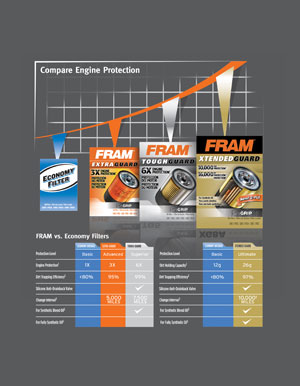Everything has a rating system: crash tests, movies, tires… so why shouldn’t your oil filter, especially as people are holding on to their cars longer.
 The FRAM team has unveiled a system to help consumers determine which of its oil filters to choose based on a new engine protection rating system. Damaging dirt and particles can threaten the life of an engine. Therefore, it’s important that motorists understand the additional protection they can get with a premium oil filter.
The FRAM team has unveiled a system to help consumers determine which of its oil filters to choose based on a new engine protection rating system. Damaging dirt and particles can threaten the life of an engine. Therefore, it’s important that motorists understand the additional protection they can get with a premium oil filter.
By utilizing International Organization for Standardization’s test method that measures a filter’s dirt holding capacity and filtering efficiency, FRAM engineers have demonstrated measurable engine protection results for its line of premium oil filters, which includes FRAM Extra Guard, FRAM Tough Guard and FRAM Xtended Guard. The chart below summarizes the levels of engine protection provided by its filters as compared to the average of leading economy filters.
“There is an important difference between an economy filter and premium filters so our goal was to bring the filter back into the spotlight during the oil change process and challenge drivers to ask themselves, ‘What’s protecting my vehicle’s oil?” said Andrew Coccari, Director of Global Marketing, Filtration for Honeywell Consumer Products Group. “The key difference between economy filters and FRAM filters is the quality of the filter media.”
Even though some filter media may look the same to the naked eye, it can be very different in terms of performance and quality. FRAM engineers use a unique technology and a more expensive media in its oil filters. The design and quality of the media material has much more bearing on filtration performance than the number of pleats or the size of the media. With thicker, highly engineered quality media, the filter design may, in fact, call for fewer pleats to improve fluid flow and filter performance.
1. The FRAM Extra Guard oil filter features a cellulose and glass blended filter media that helps improve efficiency without sacrificing performance.
2. The FRAM Tough Guard filter uses an intertwined synthetic blend media that also contains cellulose and glass. It’s thicker and has a greater percentage of synthetic fibers.
3. FRAM Xtended Guard uses a specially engineered two-ply synthetic media that is reinforced with a metal screen. This advanced filtering media provides the highest capacity out of the FRAM filter line up while still allowing for excellent efficiency.
In all FRAM filters, the media is held in place inside the oil filter canister by end caps and a special adhesive. Though many competitive filter makers use end caps made of metal; FRAM innovators developed a specially engineered rigid fiber material as an alternative. Like the fibrous filter media, they provide an excellent bonding surface for the adhesive, allowing for a very robust seal. They have proven durability in FRAM filters for over 45 years.
Celebrating its 75th anniversary this year, the FRAM oil filter is known as America’s No. 1 Consumer’s Choice. Today, the FRAM team continues to manufacture and market a wide variety of premium oil, air and fuel filters, such as the FRAM Fresh Breeze cabin air filter and the FRAM Tough Guard oil filter. The brand also produces many automotive accessories such as PCV valves, crankcase filters and transmission modulators. With six North American R&D, manufacturing and marketing locations, FRAM engineers utilize state-of-the-art process control and automated inspection equipment to assure that their products meet rigorous internal and customer requirements. More information can be found online at www.fram.com.













